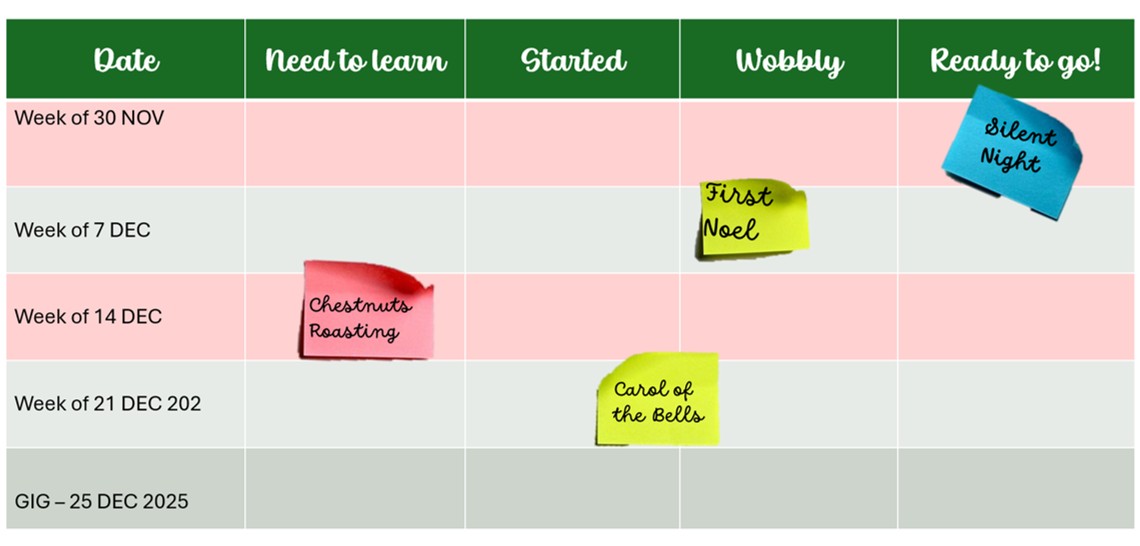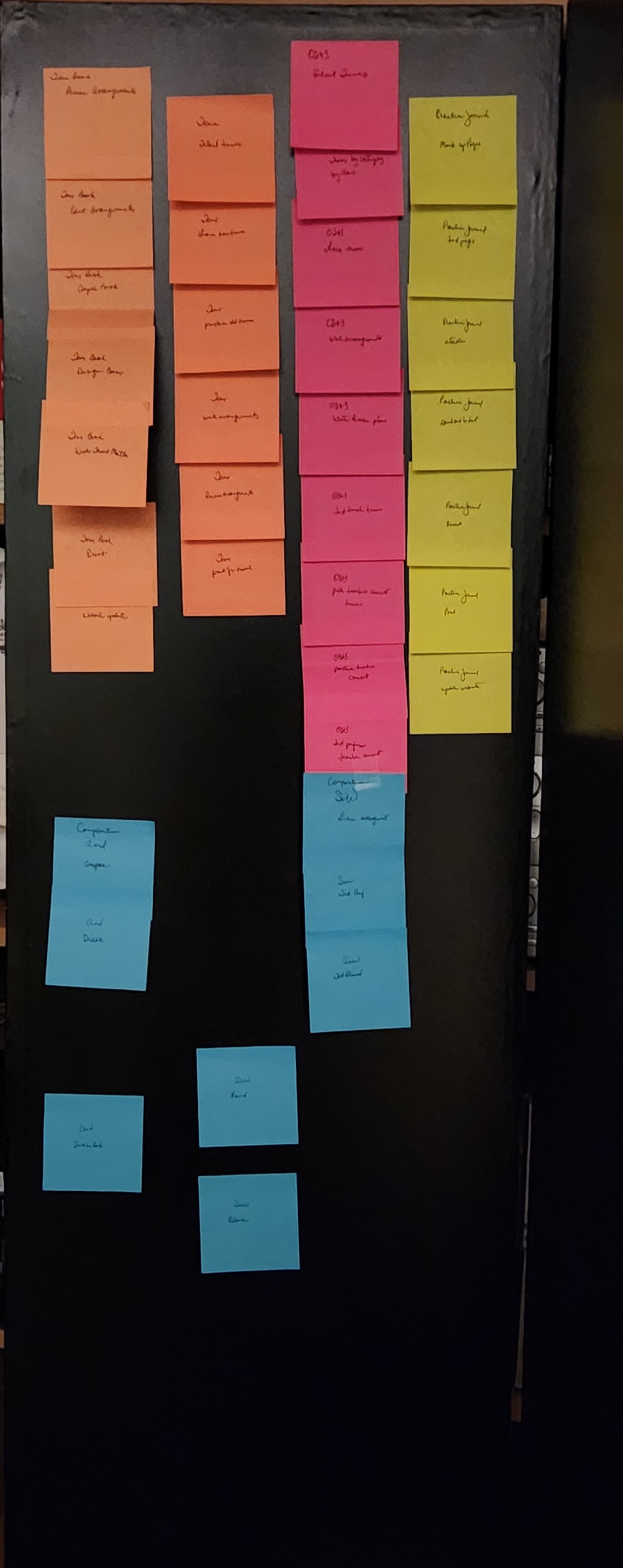It’s time for that wonderful holiday of gratitude – Thanksgiving! I hope you have a lovely day, spent with family and friends of all ilk. Thank you for being here and spending a little bit of your time each week with me. I appreciate your time and attention as well as your great comments and questions! Play some tunes and enjoy the time – and if you want to share your holiday, you know I’d love to hear about it – just use the fields below.
Month: November 2025
-
The Sticky Approach
It’s the week before Thanksgiving here in the US. This used to be the indicator that Christmas was coming. Now it’s more like Halloween starts the holidays countdown (but that’s a different diatribe!). I don’t know how you’re coming along in your preparations for playing throughout the holidays, but I find myself wishing I had an extra three weeks!
You might wonder how I know I need an extra three weeks – not two, not four, but three.* It’s because I can see where I am, where I want to be, and where I had planned to be at this point in time. (I originally typed “should be” but went with “planned” because should is such an evil, subversive word!).
How do I “see” this? I have a sticky system. Literally!
My system allows me to track each of the tunes I need to have ready for a holiday program(s) as they develop. It also allows me to see if something is just not going to be ready so I can replan for something that I will be able to play better. After all, the point of holiday gigs is to spread cheer and comfort – not to terrorize yourself trying to wow people with your brilliance! Save that for another time like competition or audition!

This graphic gives you an idea of what it could look like. And here’s a shot of mine just now.

You may have seen similar systems in your travels – this is much like kanban or scrum. Not surprising since I am a systems engineer when I’m not being a musician**, so of course I cross my tools between domains (goose/gander, etc.). The differences are that this is just for you, not a group (although you could use it for ensembles!), it is not as rigorous because we’re not building bridges (except ethereally) and we only need as much rigor as is required and not more, Finally, while on the one hand preparing music is a “project” on the other hand, it’s more than that – we’re making art not planning to pour cement or launch wonky code.
If you’re eager to start, you might want to know – what do you need to use this? Well…

First – you need sticky notes! You need as many colors as you think you need. Lined or unlined? It’s up to you!
Next, you need enough space for you to keep track of your work over time. I like the little stickies because I write small but if you need more room, use the bigger ones (they do come in sizes from 1.5 in x 2 in all the way up to 25 in x 30 in). Use the size that lets you write comfortably and fits in your usable space. I use a variety of spaces – a wall, the side of a bookcase, that photo shows one panel of a room divider and when I need to, I switch to a sheet of paper – depending on my mood and where I happen to be at the time (and if I need to take it with me). I write the name of the tune (and maybe the source if I’m reading) but you can put whatever else you decide to put there (maybe the key you’re playing in, etc.).
Now, you need a scale for time. Use whatever type of calendar you work best with. If I have a long time (e.g., tunes I might teach next year) I will use a monthly calendar. If it’s something more imminent (like the holidays) I use the week. I used to use a daily, but I found that kept me too focused on checking the box rather than learning the music. Frankly, for daily progress I use a journal so I can capture details that would just get lost on my big sticky board.
Now, you need a metric. I typically use what I have shown in the graphic – whether the tune is coming along, practically done, ready to go. This not only tells me how the tune is developing, it also helps me plan my practice – if I haven’t actually learned something at this point, it gets more attention so it can get “caught up”. You will always have some tune in this category of disrepair – how much you stress over it depends on how important it is (relative to the time you have to prepare). It’s important not to stress over these – if you’re not learning you’re not living!
You need maintenance. This tool will only help you if you set aside a little time to review and update it. In the graphic example, that would be once a week so you can see, identify, and enjoy your successes, replan your practice as needed, and keep your sanity. If you review too often, you’ll get lost in translation. This is a tool but it’s not a cudgel!
And finally, don’t forget to… Breathe.
Give it a try, play around with it. It’s not rocket surgery, but it also didn’t come down a mountain on stone tablets, so feel free to modify it so it can work for you! Then, let me know how it goes when you start. I’d love to hear what changes you made for yourself and how prepared you think you are for the holidays! Let me know in the comments!
* PS – I just learned that the em-dash is the exclusive province of AI…and me! I probably taught the model that. And I assure you, for good or bad, this is all me and NI (natural intelligence)
** Ha! I’m not sure I could be one without the other – being a musician makes me better at thinking systemically and being a systems engineer certainly informs how I think about, work with, and play music. Yet, I persist in pretending like they’re not on the same spectrum.
-
Are you In(sure)?
I am sitting in the middle of a construction zone. No really – ask my students who have been patiently waiting as the work is ongoing. My house had a little uh-oh and this is correcting that.
But the saving grace has been one of those back of the mind, cod liver oil-esque, don’t-want-to-think-about-it things – insurance. Which got me to thinking –
Is your harp insured?!

I am always amazed at the number of people I talk to who do not carry insurance on their beloved instruments! And all I can think of at that point in the conversation is, “WHY???????”
We all know that harps are expensive. And that’s true whether you’re playing a Harpsicle, a Dusty (my fav, but you already knew that), a Lyon and Healy, or any harp really. And don’t be snobby – just because you’re playing Salvi Victoria Gold doesn’t change the fact that for some, a Waring is the only affordable option. No matter who you are, or what your harp is, you should have it insured!
What we do know is that if something were to happen to our harps, we’d be deeply affected. Possibly devastated. And if we needed to replace our harp, we might be hard pressed to scrape together the cash. I know people who have lost harps to unthinkable things like auto accidents, theft, and weather. It is crushing (literally!) and heartbreaking.
So, if we ensure our homes, our cars, and our “valuable personal property” (VPP) – why wouldn’t we insure our harps? Think it’s too expensive? Ha! Think about how much the body shop wanted for that fender bender you were in. Or ask me how much it is costing to repair my home after a minor disaster. The short answer is – lots! Insurance is a small wager we make with a bunch of applied statisticians – one we are both (us and the insurers) hoping will not need to pay off. But if it’s going to pay off when needed, we have to be in the game!
How do you insure your harp? There are two easy paths – Homeowners insurance or Specialty insurance.
Homeowners insurance – you may be able to add your beautiful harp to an existing homeowners (or renters) insurance policy. Pay attention though – some homeowners insurance will not cover your instrument at all, and some have stringent value restrictions that may not support the value of your harp.
You may be able to add a VPP which is a rider that allows you to insure things that have extraordinarily high value within the auspices of your home owners or renter’s policy (valuable like your harp). Again, pay attention to the coverage limits for both value and activity. Don’t think fudging this information will be a good idea. If your VPP states that your instrument cannot leave your house, it will not be covered if you have it with you in an auto accident or if it breaks when you trip carrying it to your neighbor’s house for a party.
Putting your harp on your homeowner’s insurance is best for those of you who are beginning and/or those who only have one harp (or maybe two) and play primarily for your own pleasure.
If you have many harps, are gigging (whether you consider yourself to be a pro or not), travel with your harp a lot, or are teaching, you are likely not going to be able to use homeowner’s insurance. This includes those of you who play regularly at church, a local care home, or something like that (even if you play for free). You will need to get Specialty (“real”) instrument insurance. There are a variety of places to go for this – often affiliated with a professional organization. You already know from health insurance that this means you will be getting a “group rate” so it may be more affordable. And because it’s specialist insurance, they are more familiar with the sorts of things you will encounter when you leave your house with your harp in tow!
Since you’re going to ask, I carry harp insurance through Anderson Musical Instrument insurance. Now, this is not an endorsement, but 1. that is who I use, 2. they are the insurance endorsed by both the American Harp Society and the International Society of Folk Harpers and Craftsmen. Are they the only game in town? No, but when two big harp organizations go with them, I’m in. You do need to be a member of one or the other (but you probably should be anyway – early in my harp life, I got insurance as a member of a ISFHC chapter). If you are a member of American String Teachers Association, they use Huntington T. Block Insurance Agency, Inc. I don’t know anything about them, but there you have it, they are an option. I’m sure they’re a good insurer, but will they take on a harp as well? If you know, share so I can learn something.
No matter what kind of insurance you’re buying, things you should have on hand before you sign up include photos of your harp (get shots of the neck, the pillar, the soundboard, and the whole harp) and a bill of sale or a letter of valuation which let’s the insurance company assess the value and condition of your harp and determine it’s coverage. As I said above, do not guess or josh around with the true value of your harp when you’re talking with them – underplaying the value of your harp might reduce your premiums, but you’ll be crying if you’re underinsured!
If you are insuring harps you rent out, you need much more info (enough that I decided I didn’t want to play that game). Don’t rent out harps without insurance unless you’re wealthy enough to lose all of them and laugh about it.
So now I have ensured you know loads about insurance. I’m sure I’ve forgotten something. Do you have insurance with someone else? Have you had a good (or poor) interaction with them? Anything else that might help others insure well? Let me know in the comments!
Comments
Kate said: Oh yes, my harps had excellent coverage! I didn’t read all of your note, but the instruments need to be insured for Replacement value. it’ll be a rider on your homeowners.
Great point Kate – You do need to insure for the replacement value. I mentioned that you’ll need a bill of sale or letter of valuation from a luthier which documents that replacement value.
Robin let me know that the link in the email to send a comment isn’t working. If you’re having that same problem, try clearing the cache. And if that doesn’t work – just follow the instructions in the email to reach out or use the form here
-
What to play? Eight steps to structure your holiday program
You know that the holidays will be here soon. Probably sooner than you want but certainly no sooner than every year. And you know that everyone will want you to play for something – a party, a tea, church, or family around the tree.
And, since it comes every year, you’d think we’d have a go-to answer for what to play. And yet, every year, it starts anew – what to play? In what order? For how long? So many questions – what’s the right answer?
Well, here are 8 simple steps to organize your holiday program which can help you focus your practice and feel more confident that you’ll give your audience a lovely experience:

1. Review and refresh all the holiday music you have learned before. No tune is too insignificant to be part of this list! This is music you already have worked through and will be able to burnish relatively quickly so you can have time to spend on learning new stuff!
2. Decide how long you’re going to play (or how long they have asked you to play). This will give you some idea of how much music you will need. Or it will give you the opportunity to tell your expectant enquirer that, while you cannot play for 24 hours, you would be happy to play for 24 minutes (or whatever). The rule of thumb is about 3 minutes per tune – which is definitely true for Christmas carols since they all have at least three sets of verses and if you include an intro, a bridge-y bit and a coda of some kind, you’ll be there!
3. Define the type of holiday music you need. Are you playing a church and need all carols? Are you playing a care home and need “holiday music” (heavy on Frosty the Snowman and The Christmas Song (Chestnuts Roasting on an Open Fire)? Are you playing for children (and so need Up on the Rooftop and Ruldolph and not Have Yourself a Merry Little Christmas)? Are you playing for your family under the tree (and so need each person’s favorite, regardless of type)? Will you need to add well-known carols to fill your time? If you know your time and your rule of thumb, do you have enough tunes or do you need to start learning?
4. What keys are you playing in? While I love Sylvia Woods’ 50 Christmas Carols book, they’re almost all in the same lever setting (note they’re not all in the same key, which can get boring fast, but many are or are in varying modes). A little tonic movement will help keep your audience engaged.
5. To sing or not to sing. Are you hoping that your audience will sing along as you play? If so, you will want to play things they are likely to know the words too (and consider handing out song sheets). Also, having people sing along with you is NOT the same as imagining them singing while you practice in your silent practice room! It can be very discombobulating if you’re not used to it. If you do not want them to sing along, you might want to play less well-known music or be “artsy” in your arrangements, being so rubato that they can’t really tell when to sing!
6. What order do you want the music to occur? If you are playing a background party gig, you might order the tunes to minimize the number of times you have to change levers. But if you’re playing a showcase, you will want the music to make sense to the ears of your audience. There is a bit of an art to this, but consider the pace of the tunes, the “feel” of the mode (old tunes are often in minor keep making them feel like velvet drapes while many modern songs are like sheers – light and airy. There is no sacred order, but you’ll know it when you hear it. I often go from somber and dark to festive and light starting with the heavy, old, minor carols and working up to the ones that sound more festive. Not sure what I mean? I might start with Let All Mortal Flesh Keep Silent and end with Ding Dong Merrily on High. Both are beautiful Carols, but Let All Mortal definitely has the velvet feel while Ding Dong clearly is “skipping” like a six-year-old! If you’re playing a longer, more diverse program, don’t keep all the old tunes together and then clump the new songs. It’s a pick-and-mix so be sure you’re picking and mixing! No matter what, record your program and listen for any jarring changes – that tells you to rearrange the order of the tunes.
7. Time yourself – because you don’t want to decide you’re fine for an hour and then find out you played all your music in 10 minutes!
8. From the beginning, practice all the tunes. You want to play things you’re comfortable with. A little stretch is a good idea, but at this point learning all new music is not your safest strategy. Keep in mind though, that the music you have learned in previous years will serve you well. Even if you don’t remember it, you do and it will come back relatively quickly and with less practice than it feels like the first time you play it this year!
Finally – remember that it’s the holidays and it’s a harp – everyone is going to love what you play and be delighted with you for sharing your music! What steps do you follow to get your program ready for the holidays? Share them in the comments!
COMMENTS FROM YOU:
From Steve: I like your steps. They are good practical advice than help create a fast action plan. I like how this strategically leads to more playing (practice) and readiness rather than hem-hawing and indecisiveness. Nice timely topic!
Thanks Steve!